初中英语语法全解——代词(共35张PPT)
文档属性
| 名称 | 初中英语语法全解——代词(共35张PPT) |  | |
| 格式 | ppt | ||
| 文件大小 | 2.7MB | ||
| 资源类型 | 教案 | ||
| 版本资源 | 通用版 | ||
| 科目 | 英语 | ||
| 更新时间 | 2022-04-10 10:42:39 | ||
图片预览

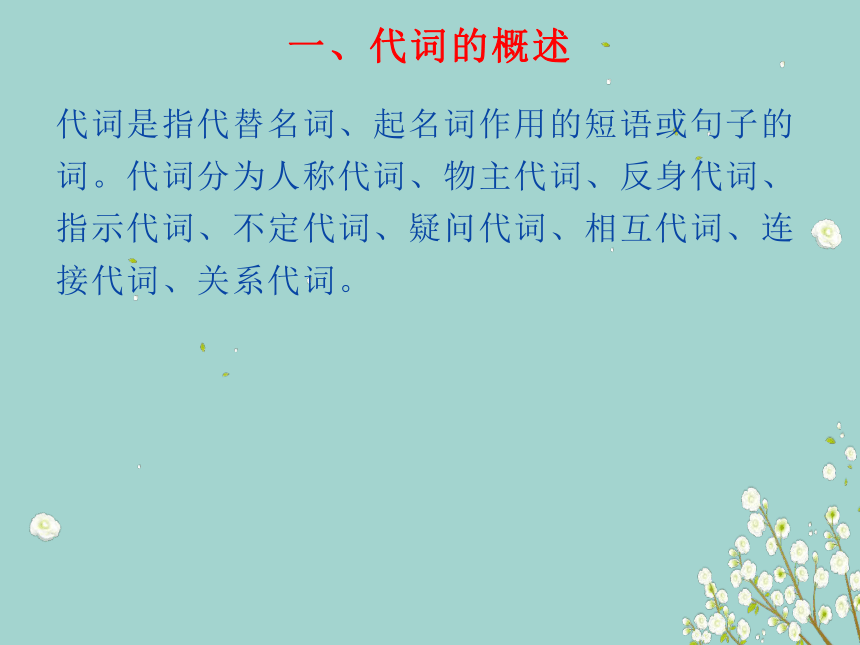
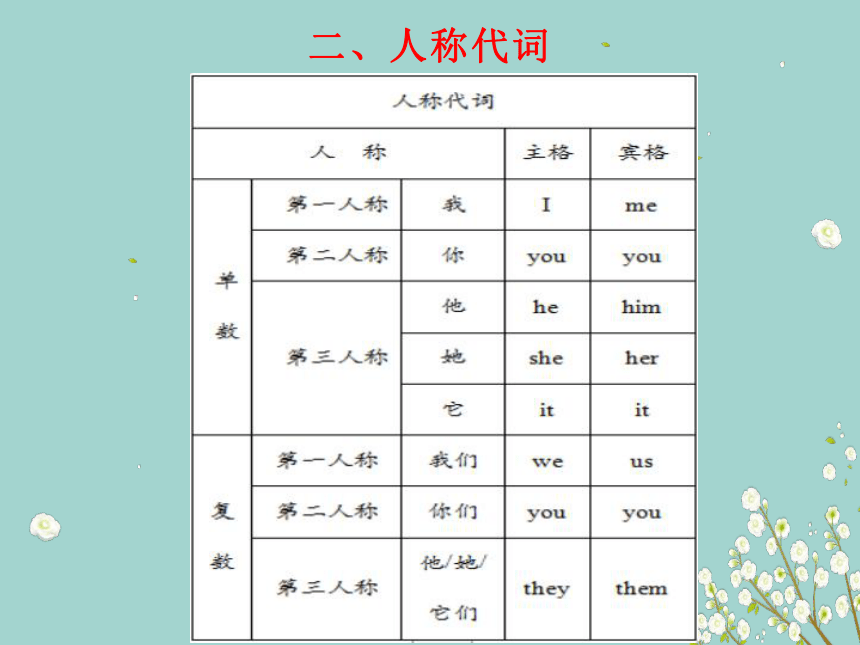

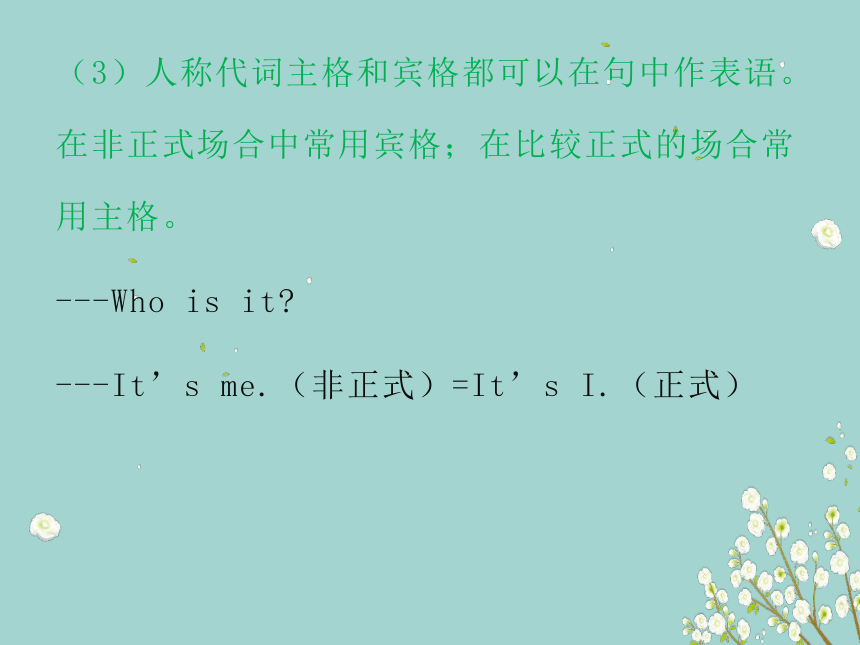
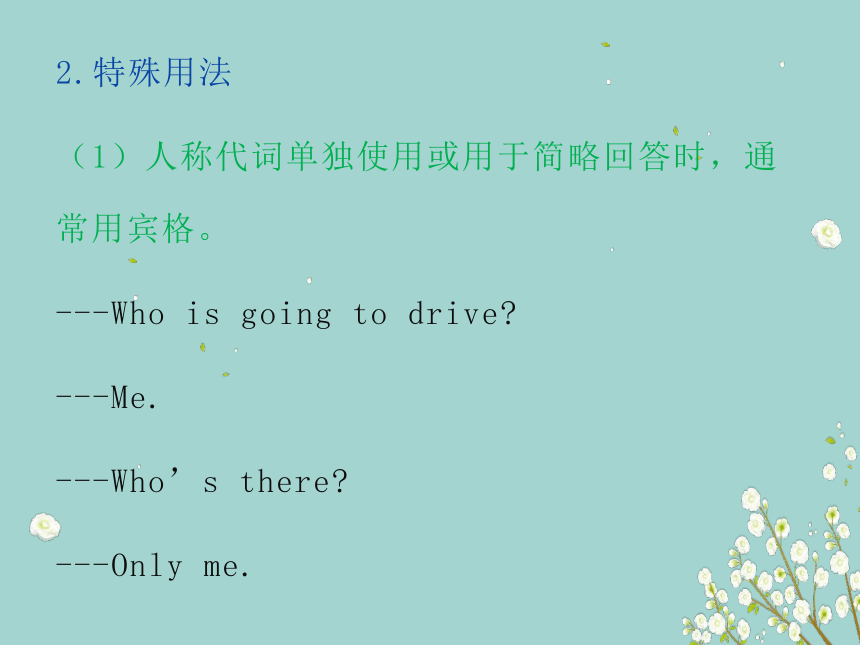
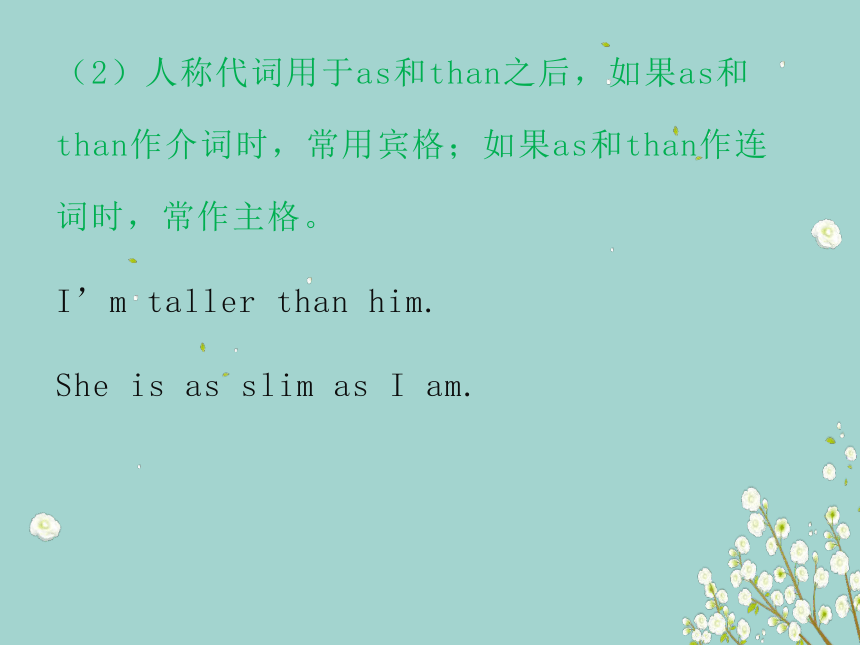
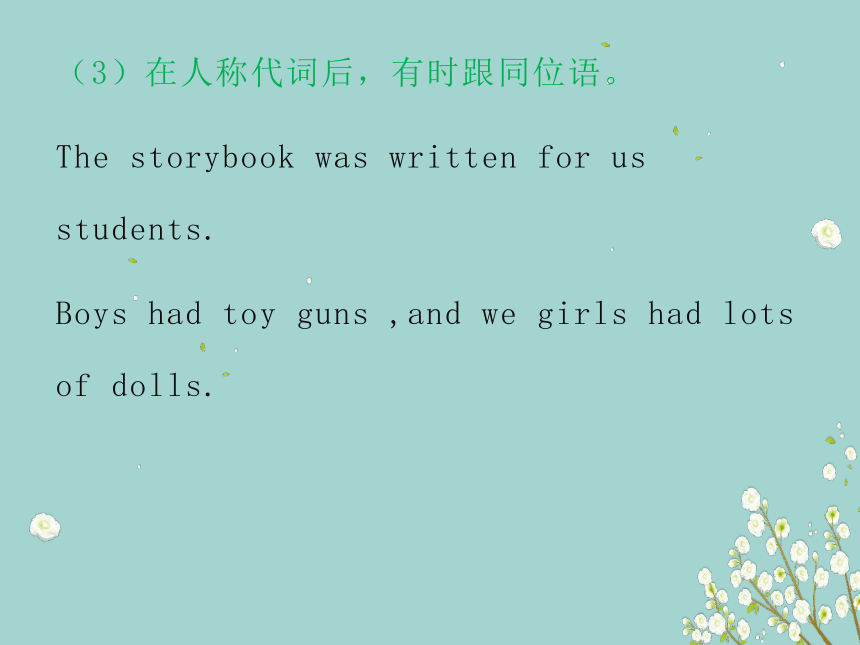
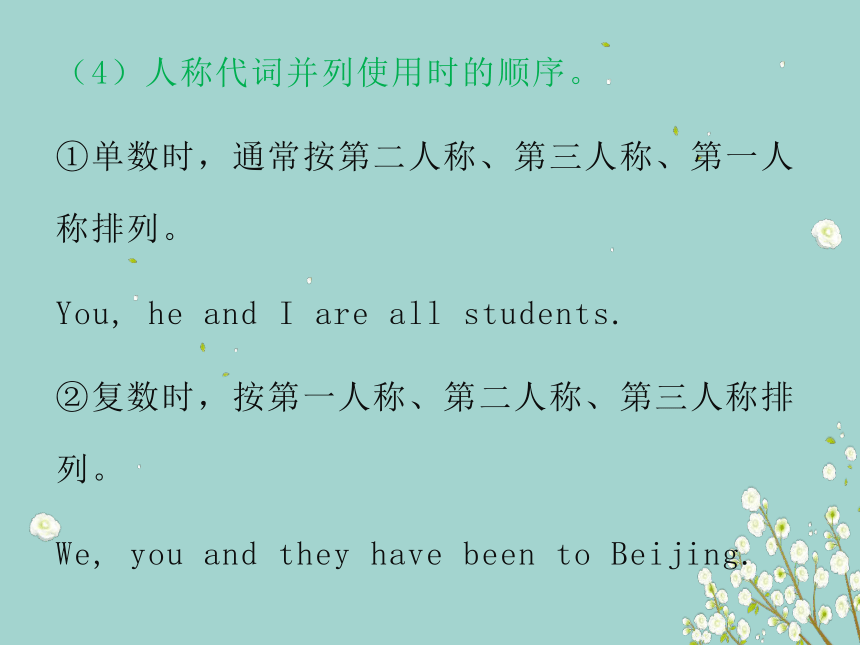
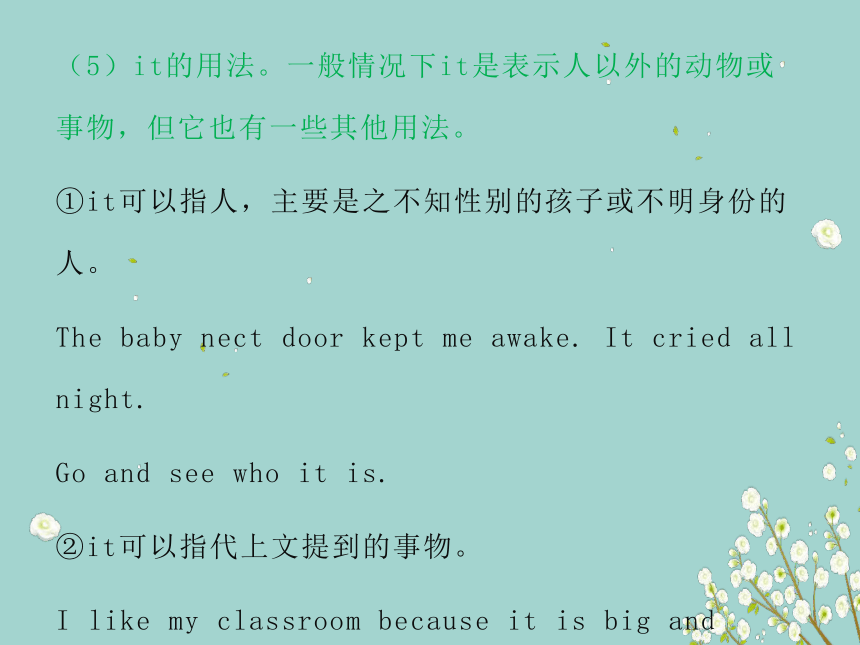
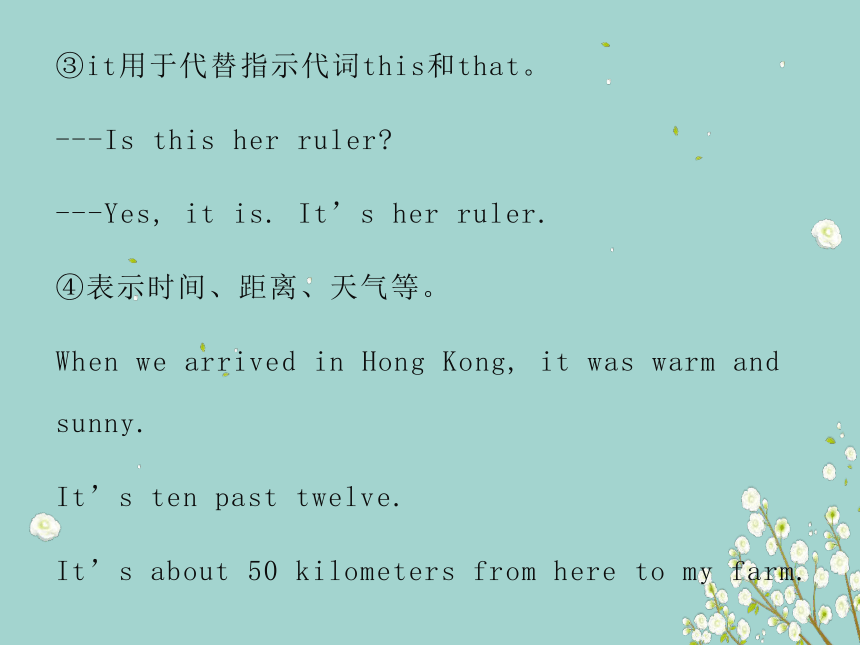
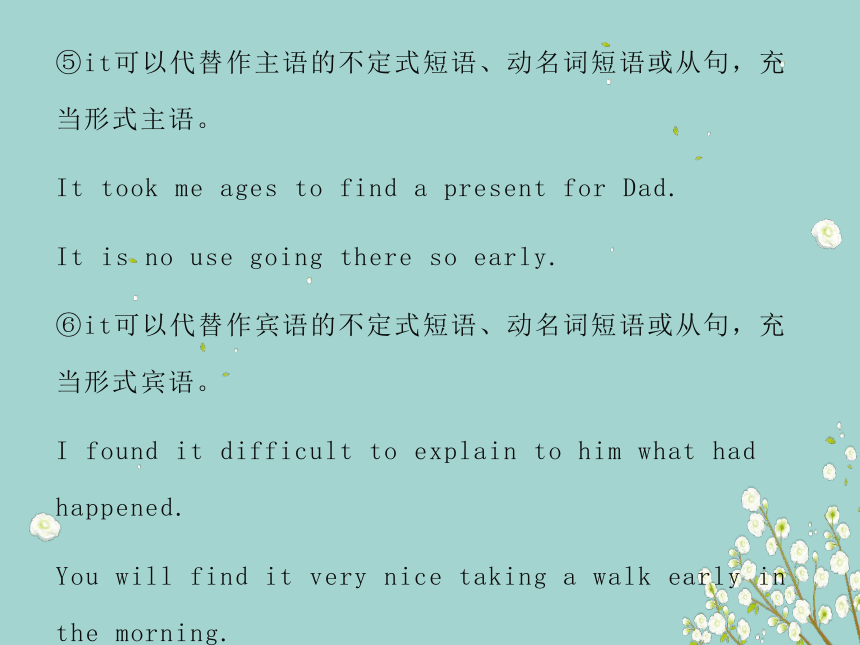
文档简介
(共35张PPT)
初中英语语法全解—代词
一、代词的概述
代词是指代替名词、起名词作用的短语或句子的词。代词分为人称代词、物主代词、反身代词、指示代词、不定代词、疑问代词、相互代词、连接代词、关系代词。
二、人称代词
1.基本用法
(1)人称代词主格在句中作主语。
I can help to buy some of the food and drinks.
(2)人称代词宾格在句中作动词或介词的宾语。
He bought me a drink.
I looked after the kids for them.
(3)人称代词主格和宾格都可以在句中作表语。在非正式场合中常用宾格;在比较正式的场合常用主格。
---Who is it
---It’s me.(非正式)=It’s I.(正式)
2.特殊用法
(1)人称代词单独使用或用于简略回答时,通常用宾格。
---Who is going to drive
---Me.
---Who’s there
---Only me.
(2)人称代词用于as和than之后,如果as和than作介词时,常用宾格;如果as和than作连词时,常作主格。
I’m taller than him.
She is as slim as I am.
(3)在人称代词后,有时跟同位语。
The storybook was written for us students.
Boys had toy guns ,and we girls had lots of dolls.
(4)人称代词并列使用时的顺序。
①单数时,通常按第二人称、第三人称、第一人称排列。
You, he and I are all students.
②复数时,按第一人称、第二人称、第三人称排列。
We, you and they have been to Beijing.
(5)it的用法。一般情况下it是表示人以外的动物或事物,但它也有一些其他用法。
①it可以指人,主要是之不知性别的孩子或不明身份的人。
The baby nect door kept me awake. It cried all night.
Go and see who it is.
②it可以指代上文提到的事物。
I like my classroom because it is big and clean.
③it用于代替指示代词this和that。
---Is this her ruler
---Yes, it is. It’s her ruler.
④表示时间、距离、天气等。
When we arrived in Hong Kong, it was warm and sunny.
It’s ten past twelve.
It’s about 50 kilometers from here to my farm.
⑤it可以代替作主语的不定式短语、动名词短语或从句,充当形式主语。
It took me ages to find a present for Dad.
It is no use going there so early.
⑥it可以代替作宾语的不定式短语、动名词短语或从句,充当形式宾语。
I found it difficult to explain to him what had happened.
You will find it very nice taking a walk early in the morning.
三、物主代词
1. 物主代词的形式
物主代词分为形容词性物主代词和名词性物主代词。有人称和数之分,第三人称单数还有性别之分。
2.物主代词的用法
(1)形容词性物主代词相当于形容词,只能置于名词之前作定语。
This is my friend.
(2)名词性物主代词相当于名词,在句子中可以作主语、宾语、表语,也可以与of连用作定语,但不能置于名词前作定语。
---Is that your car
---No, mine is parked over the road.
The idea was hers.
四、反身代词
1.反身代词的形式
2.反身代词的用法
①反身代词常用作动词enjoy,hurt,teach,help,introduce等的宾语。表示动作返回到动作执行者本身,即主语和宾语是指同一个(些)人或物。
Go and buy yourself an ice cream.
I always enjoy myself.
②反身代词也可以用作介词的宾语。
Look at yourself in the mirror.
He learned English by himself.
五、指示代词
1.指示代词的形式
2.指示代词的用法
指示代词在句中可以作主语、定语、表语和宾语。
That was a good trip.
I have read that in some magazine.(作宾语)
What I want to know is this.(作表语)
①this和these的用法
this意为“这个”;these意为“这些”。它们都用来指代在时间或空间上较近的人或事物。
This has been the worst year of my life.
I think you’ll fins these more comfortable than those.
②that和those的用法
that意为“那个”;those意为“那些”。它们都用来指代在时间或空间上较远的人或事物。
That’s a nice dress.
Those look riper than these.
③指示代词的特殊用法
(1)打电话时,this指自己,that指对方。
Hello! This is Jim. Is that Mr Black speaking
(2)that和those可以用来代替前面提到过的事物,但this和these不能这样用。
The area of the bedroom is larger than that of the sitting room.
The bikes made in Chongqing are as good as those made in Shanghai.
六、不定代词
1.不定代词的概述
不定代词是指不明确指代某个(些)人或事物的代词。他们用来修饰或代替不确定的人或事物。不定代词在句中可以作主语、宾语、表语或定语等。
Do people remember anything or anyone on the day (作宾语)
How many bananas do we need (作定语)
2.some和any的用法
some和any都表示“一些”的意思,既可以待提货修饰可数名词,也可以代替或修饰不可数名词。some一般用于肯定句中;any一般用于否定句、一般疑问句和条件句中。
Some of my friends are Indians.
Some of them danced, and others talked and played games.
Do you know any of those people
3.many和much的用法
many和much都表示“许多”的意思。many在句中代替或修饰可数名词;much在句中代替或秀是不可数名词。
I have many friends.
I haven’t got much money.
4.both和all的用法
(1)both表示“两者都”,作主语时,谓语动词要用复数。
(2)all表示“三者或三者以上都”,可以代替或修饰可数名词,也可以代替或修饰不可数名词。all作主语,指事物的整体或抽象概念时,谓语动词用单数;指复数的人或物时,谓语动词用复数。
I know that all is well with her.
All are equal before the law.
5.neither和none的用法
(1)neither和none都表示全部否定。neither表示“两者都不”;none表示“三者或三者以上都不”。
Neither of my parents is a teacher.
Although these were good students, none had a score above 60.
(2)neither作主语时,谓语动词常用单数;none代替不可数名词作主语时,谓语动词用单数,none代替可数名词作主语时,谓语动词可以用单数,也可以用复数。
He tasted both cakes. Neither was good.
None of these pens works/work.
6.either,each和every的用法
(1)either表示“两者中的任何一个”。可以与单数名词连用,也可以与of搭配。作主语时,谓语动词用单数。
You can park on either side of the street.
Did you see either of the boys
Either of them is good enough.
(2)each可以跟单数可数名词连用,也可以单独使用。each强调个体,可用于两者之间,也可以用于三者或三者以上,可以和of连用。在句中可以作主语、宾语或同位语。作主语时,谓语动词用单数。
Listen and write each person’s name under the correct picture.
I’m going to ask each of you to speak for three minutes.
(3)every强调整体,用于三者或撒着以上,其后必须跟单数可数名词作定语,不可以单独使用,也不能与of连用。
I enjoyed every minute of the film.
7.(a)few和(a)little的用法
(1)few和a few用于代替或修饰可数名词。a few意为“有几个;有一些”,表示肯定意义;而few意为“几乎没有”,表示否定意义。
I have a few friends here, but few good friends.
(2)little和a little用于代替或修饰不可数名词。a little意为“一点儿”,表示肯定意义;而little意为“几乎没有”,表示否定意义。
8. one(s)的用法
(1)one作代词,用来代替上文出现过的同类单数名词,以免重复,可以指人,也可以指物。若要代替同类复数名词时,需用ones。
---Are there any science labs Where are they
---Yes,there is one behind the library.
it,one和that都可以用来代替上文提到的人或物,但it指同一事物;one指同名异物,并且前面可以有修饰词,只代替可数名词;that指同一类,并非同一个,用于指代不可数名词。
七、疑问代词
1.疑问代词who,whom和whose的用法
①who意为“谁”,在句中可以作主语、宾语和表语。
---Who’s he ---He’s my brother.
②whom意为“谁”,在句中只能作宾语。作动词的宾语时,可以与who互换;但作介词的宾语且位于介词之后时,只能用whom。
I spent two hours talking to Kate, whom I’d met only once before.
With whom did you celebrate your birthday
③whose意为“谁的”,在句中可以作主语、定语和表语。
---Whose watch is this ---It’s mine.
3.疑问代词what和which的用法
what意为“什么”,which意为“哪一个”,它们都可以单独使用,也可以放在名词之前。在句中作主语、宾语、表语和定语。
What are you doing
What language does she speak
Which is better exercise——swimming or tennis
1.what是泛指“哪一类”,而which是指在一定范围内的选择。
What subjects did you enjoying most
Which animals do you like better, monkeys or tigers
2.what用于询问职业,而who用于询问身份。
---What does she do
---She’s a doctor.
---Who are they
---They are my grandparents.
八、相互代词
相互代词时用来表示相互关系的代词。相互代词只有each other和one another,意为“相互”。each other通常指两者之间;one another用于指三者或三者以上。但在实际运用中,两者可以互换。
We always chat with each other or play games.
初中英语语法全解—代词
一、代词的概述
代词是指代替名词、起名词作用的短语或句子的词。代词分为人称代词、物主代词、反身代词、指示代词、不定代词、疑问代词、相互代词、连接代词、关系代词。
二、人称代词
1.基本用法
(1)人称代词主格在句中作主语。
I can help to buy some of the food and drinks.
(2)人称代词宾格在句中作动词或介词的宾语。
He bought me a drink.
I looked after the kids for them.
(3)人称代词主格和宾格都可以在句中作表语。在非正式场合中常用宾格;在比较正式的场合常用主格。
---Who is it
---It’s me.(非正式)=It’s I.(正式)
2.特殊用法
(1)人称代词单独使用或用于简略回答时,通常用宾格。
---Who is going to drive
---Me.
---Who’s there
---Only me.
(2)人称代词用于as和than之后,如果as和than作介词时,常用宾格;如果as和than作连词时,常作主格。
I’m taller than him.
She is as slim as I am.
(3)在人称代词后,有时跟同位语。
The storybook was written for us students.
Boys had toy guns ,and we girls had lots of dolls.
(4)人称代词并列使用时的顺序。
①单数时,通常按第二人称、第三人称、第一人称排列。
You, he and I are all students.
②复数时,按第一人称、第二人称、第三人称排列。
We, you and they have been to Beijing.
(5)it的用法。一般情况下it是表示人以外的动物或事物,但它也有一些其他用法。
①it可以指人,主要是之不知性别的孩子或不明身份的人。
The baby nect door kept me awake. It cried all night.
Go and see who it is.
②it可以指代上文提到的事物。
I like my classroom because it is big and clean.
③it用于代替指示代词this和that。
---Is this her ruler
---Yes, it is. It’s her ruler.
④表示时间、距离、天气等。
When we arrived in Hong Kong, it was warm and sunny.
It’s ten past twelve.
It’s about 50 kilometers from here to my farm.
⑤it可以代替作主语的不定式短语、动名词短语或从句,充当形式主语。
It took me ages to find a present for Dad.
It is no use going there so early.
⑥it可以代替作宾语的不定式短语、动名词短语或从句,充当形式宾语。
I found it difficult to explain to him what had happened.
You will find it very nice taking a walk early in the morning.
三、物主代词
1. 物主代词的形式
物主代词分为形容词性物主代词和名词性物主代词。有人称和数之分,第三人称单数还有性别之分。
2.物主代词的用法
(1)形容词性物主代词相当于形容词,只能置于名词之前作定语。
This is my friend.
(2)名词性物主代词相当于名词,在句子中可以作主语、宾语、表语,也可以与of连用作定语,但不能置于名词前作定语。
---Is that your car
---No, mine is parked over the road.
The idea was hers.
四、反身代词
1.反身代词的形式
2.反身代词的用法
①反身代词常用作动词enjoy,hurt,teach,help,introduce等的宾语。表示动作返回到动作执行者本身,即主语和宾语是指同一个(些)人或物。
Go and buy yourself an ice cream.
I always enjoy myself.
②反身代词也可以用作介词的宾语。
Look at yourself in the mirror.
He learned English by himself.
五、指示代词
1.指示代词的形式
2.指示代词的用法
指示代词在句中可以作主语、定语、表语和宾语。
That was a good trip.
I have read that in some magazine.(作宾语)
What I want to know is this.(作表语)
①this和these的用法
this意为“这个”;these意为“这些”。它们都用来指代在时间或空间上较近的人或事物。
This has been the worst year of my life.
I think you’ll fins these more comfortable than those.
②that和those的用法
that意为“那个”;those意为“那些”。它们都用来指代在时间或空间上较远的人或事物。
That’s a nice dress.
Those look riper than these.
③指示代词的特殊用法
(1)打电话时,this指自己,that指对方。
Hello! This is Jim. Is that Mr Black speaking
(2)that和those可以用来代替前面提到过的事物,但this和these不能这样用。
The area of the bedroom is larger than that of the sitting room.
The bikes made in Chongqing are as good as those made in Shanghai.
六、不定代词
1.不定代词的概述
不定代词是指不明确指代某个(些)人或事物的代词。他们用来修饰或代替不确定的人或事物。不定代词在句中可以作主语、宾语、表语或定语等。
Do people remember anything or anyone on the day (作宾语)
How many bananas do we need (作定语)
2.some和any的用法
some和any都表示“一些”的意思,既可以待提货修饰可数名词,也可以代替或修饰不可数名词。some一般用于肯定句中;any一般用于否定句、一般疑问句和条件句中。
Some of my friends are Indians.
Some of them danced, and others talked and played games.
Do you know any of those people
3.many和much的用法
many和much都表示“许多”的意思。many在句中代替或修饰可数名词;much在句中代替或秀是不可数名词。
I have many friends.
I haven’t got much money.
4.both和all的用法
(1)both表示“两者都”,作主语时,谓语动词要用复数。
(2)all表示“三者或三者以上都”,可以代替或修饰可数名词,也可以代替或修饰不可数名词。all作主语,指事物的整体或抽象概念时,谓语动词用单数;指复数的人或物时,谓语动词用复数。
I know that all is well with her.
All are equal before the law.
5.neither和none的用法
(1)neither和none都表示全部否定。neither表示“两者都不”;none表示“三者或三者以上都不”。
Neither of my parents is a teacher.
Although these were good students, none had a score above 60.
(2)neither作主语时,谓语动词常用单数;none代替不可数名词作主语时,谓语动词用单数,none代替可数名词作主语时,谓语动词可以用单数,也可以用复数。
He tasted both cakes. Neither was good.
None of these pens works/work.
6.either,each和every的用法
(1)either表示“两者中的任何一个”。可以与单数名词连用,也可以与of搭配。作主语时,谓语动词用单数。
You can park on either side of the street.
Did you see either of the boys
Either of them is good enough.
(2)each可以跟单数可数名词连用,也可以单独使用。each强调个体,可用于两者之间,也可以用于三者或三者以上,可以和of连用。在句中可以作主语、宾语或同位语。作主语时,谓语动词用单数。
Listen and write each person’s name under the correct picture.
I’m going to ask each of you to speak for three minutes.
(3)every强调整体,用于三者或撒着以上,其后必须跟单数可数名词作定语,不可以单独使用,也不能与of连用。
I enjoyed every minute of the film.
7.(a)few和(a)little的用法
(1)few和a few用于代替或修饰可数名词。a few意为“有几个;有一些”,表示肯定意义;而few意为“几乎没有”,表示否定意义。
I have a few friends here, but few good friends.
(2)little和a little用于代替或修饰不可数名词。a little意为“一点儿”,表示肯定意义;而little意为“几乎没有”,表示否定意义。
8. one(s)的用法
(1)one作代词,用来代替上文出现过的同类单数名词,以免重复,可以指人,也可以指物。若要代替同类复数名词时,需用ones。
---Are there any science labs Where are they
---Yes,there is one behind the library.
it,one和that都可以用来代替上文提到的人或物,但it指同一事物;one指同名异物,并且前面可以有修饰词,只代替可数名词;that指同一类,并非同一个,用于指代不可数名词。
七、疑问代词
1.疑问代词who,whom和whose的用法
①who意为“谁”,在句中可以作主语、宾语和表语。
---Who’s he ---He’s my brother.
②whom意为“谁”,在句中只能作宾语。作动词的宾语时,可以与who互换;但作介词的宾语且位于介词之后时,只能用whom。
I spent two hours talking to Kate, whom I’d met only once before.
With whom did you celebrate your birthday
③whose意为“谁的”,在句中可以作主语、定语和表语。
---Whose watch is this ---It’s mine.
3.疑问代词what和which的用法
what意为“什么”,which意为“哪一个”,它们都可以单独使用,也可以放在名词之前。在句中作主语、宾语、表语和定语。
What are you doing
What language does she speak
Which is better exercise——swimming or tennis
1.what是泛指“哪一类”,而which是指在一定范围内的选择。
What subjects did you enjoying most
Which animals do you like better, monkeys or tigers
2.what用于询问职业,而who用于询问身份。
---What does she do
---She’s a doctor.
---Who are they
---They are my grandparents.
八、相互代词
相互代词时用来表示相互关系的代词。相互代词只有each other和one another,意为“相互”。each other通常指两者之间;one another用于指三者或三者以上。但在实际运用中,两者可以互换。
We always chat with each other or play games.
同课章节目录
- 词法
- 名词
- 动词和动词短语
- 动词语态
- 动词时态
- 助动词和情态动词
- 非谓语动词
- 冠词
- 代词
- 数词和量词
- 形容词副词及其比较等级
- 介词和介词短语
- 连词和感叹词
- 构词法
- 相似、相近词比较
- 句法
- 陈述句
- 一般疑问句和否定疑问句
- 特殊疑问句及选择疑问句
- 反意疑问句
- 存在句(There be句型)
- 宾语从句
- 定语从句
- 状语从句
- 主谓一致问题
- 简单句
- 并列句
- 复合句
- 主谓一致
- 主、表语从句
- 名词性从句
- 直接引语和间接引语
- 虚拟语气
- 感叹句
- 强调句
- 倒装句
- 祈使句
- 句子的成分
- 句子的分类
- 题型专区
- 单项选择部分
- 易错题
- 完形填空
- 阅读理解
- 词汇练习
- 听说训练
- 句型转换
- 补全对话
- 短文改错
- 翻译
- 书面表达
- 任务型阅读
- 语法填空
- 其他资料
